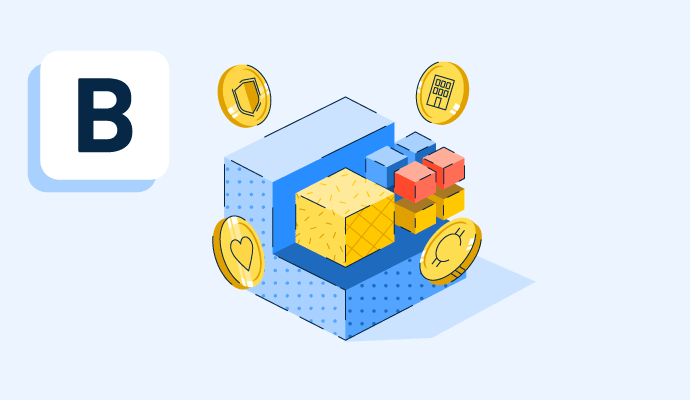What are blockchain assets?
Blockchain assets are digital assets created, stored, or transferred across a decentralized blockchain network. These assets are secure and transparent and facilitate peer-to-peer transactions.
Cryptography secures transactions of blockchain assets and governs the creation of new units. Any assets that have virtual value can be traded on the blockchain network with minimal risk and cost savings.
Many developers use blockchain as a service providers to build and develop assets on a hosted blockchain. These assets can have a transactional value, or businesses can use them as a verification token.
Types of blockchain assets
Blockchain assets are of different types and have various uses. Here are some of the most common ones.
- Cryptocurrency is a payment currency that uses blockchain technology and cryptography to secure and facilitate peer-to-peer transactions. Market supply and demand are the key determinants of cryptocurrencies’ value. Bitcoin (BTC) and Ethereum (ETH) are some of the common cryptocurrencies.
- Blockchain platforms provide options to create new assets and create decentralized apps (dApps) on their platform. Some famous blockchain economies are Ethereum, Ethereum Classic (ETC), and Electro-Optical System (EOS).
- Utility tokens enable access to specific blockchain products or services within the blockchain economy. These tokens are used within decentralized apps and platforms to benefit from the service or product purchased. Most utility tokens are ERC20 tokens that run primarily on the Ethereum platform.
- Security tokens are investments where the token holder is promised a profitability stake against the investment. It can be shares, equities, and debt instruments with an assumption of a profitable return.
- Non-fungible tokens (NFTs) are unique blockchain assets with ownership and authenticity of any particular item. The rarity of the specific item determines the value of it. It can be any item, from a simple message to a car or a work of art, not restricted by size and shape.
- Stablecoins are known for their stable price. They also minimize the effect of price volatility because they are pegged to an external asset like any fiat currency or an external commodity like gold. This stability in price makes stablecoins a medium of exchange on the blockchain network.
- Governance tokens permit the holder to participate in the decision-making process of blockchain networks. They grant token holders the right to vote on new proposals, ideas, changes, or any other network-related crucial decision. This is to make sure network functioning is smooth.
Features of blockchain assets
A few unique characteristics differentiate blockchain assets from other digital assets. Here are some of the key features of blockchain assets:
- Decentralization: There is no centralized authority or entity to regulate blockchain networks and the transactions through these networks.
- Security: Blockchain assets use cryptographic techniques to ensure safety, privacy, and protection. Blockchain technology's fixed character prevents fraud or unauthorized activities, ensuring complete security.
- Transparency: Blockchain transactions are transparent since the transaction history is publicly available. This transparency restricts potential fraud and ensures security.
- Automation: Few blockchain networks enable predefined agreements and rules. This automation and pre-programmed actions help in carrying out complex transactions.
- Interoperability: It allows blockchain assets and networks to communicate and interact with another asset or network.
- Divisibility: Blockchain assets like cryptocurrencies have the option of dividing into multiple smaller units, enabling a large number of users to own the asset. This also helps the asset reach a broader set of users and pliable transactions.
- Global accessibility: Blockchain assets aren’t bound to geographical boundaries. Users from across the globe can transact and own these assets.
Operational elements of blockchain assets
A blockchain network is a network of computers known as nodes. Nodes maintain a shared database, which is called a blockchain. Every node has visibility into the whole blockchain, and these nodes participate in authenticating and approving transactions. Below are some vital elements in blockchain asset operations.
- Transaction creation: The user starts a transaction by specifying essential details of the sender, the receiver, and asset value in a digital record and digitally signs it.
- Transaction verification: Transaction details will be available to all the nodes in the network, and it will verify if the transaction complies with all the requirements.
- Block formation: Once a transaction is validated, blocks will be formed. Validated transactions will be added to these blocks. Each block contains a chunk of transactions and references to previous transactions, creating a chain of blocks.
- Consensus mechanism: The system uses a consensus mechanism to confirm the transactions in order to maintain security and quality.
- Block validation: Validators solve a puzzle or use their assets to validate one transaction block. Upon successful verification, a block will be added to the respective chain.
- Asset ownership and transfer: Assets are then represented by a unique token with a cryptographic key. The possession of this key represents ownership. Once the ownership is transferred, this will be updated in the blockchain mentioning the new owner.
Blockchain assets storage
A blockchain records and saves all transactions, asset details, and ownership information. Blockchain assets are stored in the blockchain network itself using its decentralized infrastructure. There are two integral parts to blockchain asset storage.
- Distributed ledgers: All nodes in the network have a copy of the complete distributed ledger. This helps maintain accuracy and gives clear visibility to the nodes. All nodes will have similar information about asset ownership and transactions.
- Crypto wallets: Users leverage crypto wallets to store their blockchain assets. Wallets are used to store crucial data like private keys and proof of asset ownership.
Blockchain assets vs. bitcoins
Blockchain is a peer-to-peer ledger technology that spreads data across several computers, making it decentralized. Blockchain assets are digital assets created, stored, or transferred across this decentralized network.
Bitcoin allows more accessible and faster transactions without any limitations from the government. It’s a kind of uncontrolled digital money made to bypass government currency regulations. It allows and simplifies online transactions without an intermediary.
Learn how to mine Bitcoins and discover ways to create blocks for crypto mining.

 by Michael Pigott
by Michael Pigott
 by Sagar Joshi
by Sagar Joshi
 by Keerthi Rangan
by Keerthi Rangan
 by Michael Pigott
by Michael Pigott
 by Sagar Joshi
by Sagar Joshi


